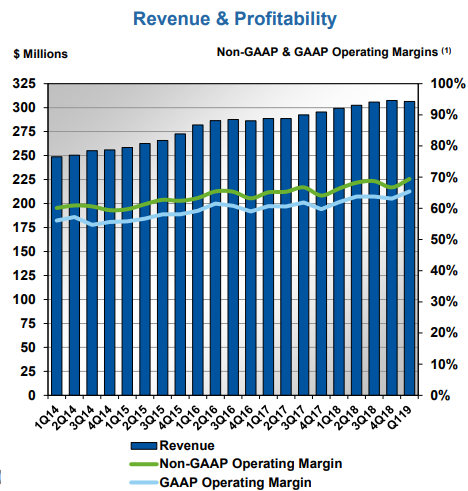Results continue to tick upward as company pushes for price increases.

.Com registry Verisign (NASDAQ: VRSN) reported first quarter earnings yesterday afternoon.
It generated $306 million revenue for the quarter and a 69.4% non-GAAP operating margin. The business created $187 million in operating cash flow.
People registered 9.8 million .com and .net domain names in the first quarter of the year, resulting in net growth of 1.82 million in the domain base for these two top level domain names.
The company narrowed its guidance for the year by removing the lower end. It now expects $1.220 billion to $1.235 billion in revenue. It expects the .com/.net domain base to increase by 2.5% to 4.25% by the end of the year.
On the conference call, most analysts wanted to understand the status of .Web (it’s in arbitration between Afilias and ICANN but Verisign wants to join the arbitration) and .com price increases (Verisign is working through a process with ICANN to get the price increases that the NTIA approved.)






Even at current .com pricing, Versign is clearly exceedingly profitable. Apparently running a secure database with a robust infrastructure that allows one to profit from every .com domain that is registered or renewed is a pretty nice business to be in.
We’ll see whether ICANN will allow Verisign to pad its profits even more by continuing to raise prices on .com registrants. At the moment, ICANN appears to view its role as forcing anyone who wants to have a web presence to enter into a long-term extortionate relationship with a registry who, once you establish your web presence, can jack up your renewal fees to whatever level they wish.
After looking at the nature of proposals put forward by ICANN recently(Remove price caps for .org and .info), do you think they will so no to 7% annual hike of .com price?
Only thing they will negotiate is increase in their cut per domain/year.
The forgotten word:
https://www.ftc.gov/tips-advice/competition-guidance/guide-antitrust-laws/single-firm-conduct/monopolization-defined
“That is how that term is used here: a “monopolist” is a firm with significant and durable market power. Courts look at the firm’s market share, but typically do not find monopoly power if the firm (or a group of firms acting in concert) has less than 50 percent of the sales of a particular product or service within a certain geographic area. Some courts have required much higher percentages. In addition, that leading position must be sustainable over time: if competitive forces or the entry of new firms could discipline the conduct of the leading firm, courts are unlikely to find that the firm has lasting market power.”
Fortunately for Verisign, ICANN severely damaged Alt Roots so competitive forces can’t discipline Verisign.
The game then gets played, “its easy to change the TLD”. Lets have ICANN prove that to be the case by retaining the ICANN.ORG, dezoning it, and then switching to ICANN.XYZ. And also do it for IANA.ORG, dezone, and switch to IANA.XYZ.
If they say we can do it, then they can do it right?
Go ahead ICANN, prove there is no difference between .ORG and .XYZ by being the example we can all follow. Time to step up and BE THE EXAMPLE.
>Fortunately for Verisign, ICANN severely damaged
>Alt Roots so competitive forces can’t discipline Verisign.
ie the “interesting” history of .WEB …
https://icannwiki.org/Chris_Ambler
In 1995, Christopher Ambler’s company IOD, submitted the first request to own and obtain the TLD, .web.
https://www.wired.com/2000/03/a-ralph-nader-plan-that-sucks/
1995 …. 1995 …. 1995 ….
Under capitalism, a company can only really make a lot of money when it occupies a monopoly position.
The problem for Verisign — what is the price to maximise profits? Big increases could kill the golden egg! If it’s not broke — don ‘t fix it! So many volume domainers are at tight margins. Demand I would say is definitely elastic. But by how how much is hard to know. Either way — we are about to find out!